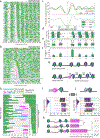RNA polymerases reshape chromatin architecture and couple transcription on individual fibers
- PMID: 39191261
- PMCID: PMC11500009
- DOI: 10.1016/j.molcel.2024.08.013
RNA polymerases reshape chromatin architecture and couple transcription on individual fibers
Abstract
RNA polymerases must initiate and pause within a complex chromatin environment, surrounded by nucleosomes and other transcriptional machinery. This environment creates a spatial arrangement along individual chromatin fibers ripe for both competition and coordination, yet these relationships remain largely unknown owing to the inherent limitations of traditional structural and sequencing methodologies. To address this, we employed long-read chromatin fiber sequencing (Fiber-seq) in Drosophila to visualize RNA polymerase (Pol) within its native chromatin context with single-molecule precision along up to 30 kb fibers. We demonstrate that Fiber-seq enables the identification of individual Pol II, nucleosome, and transcription factor footprints, revealing Pol II pausing-driven destabilization of downstream nucleosomes. Furthermore, we demonstrate pervasive direct distance-dependent transcriptional coupling between nearby Pol II genes, Pol III genes, and transcribed enhancers, modulated by local chromatin architecture. Overall, transcription initiation reshapes surrounding nucleosome architecture and couples nearby transcriptional machinery along individual chromatin fibers.
Keywords: Fiber-seq; RNA Pol II; RNA Pol III; chromatin; nucleosome; promoter proximal pausing; single-molecule; transcription initiation.
Copyright © 2024 Elsevier Inc. All rights reserved.
Conflict of interest statement
Declaration of interests A.B.S. is a co-inventor on a patent relating to the Fiber-seq method (US17/995,058).
Figures





Update of
-
RNA polymerases reshape chromatin and coordinate transcription on individual fibers.bioRxiv [Preprint]. 2023 Dec 23:2023.12.22.573133. doi: 10.1101/2023.12.22.573133. bioRxiv. 2023. Update in: Mol Cell. 2024 Sep 5;84(17):3209-3222.e5. doi: 10.1016/j.molcel.2024.08.013. PMID: 38187631 Free PMC article. Updated. Preprint.
References
MeSH terms
Substances
Grants and funding
LinkOut - more resources
Full Text Sources
Molecular Biology Databases

